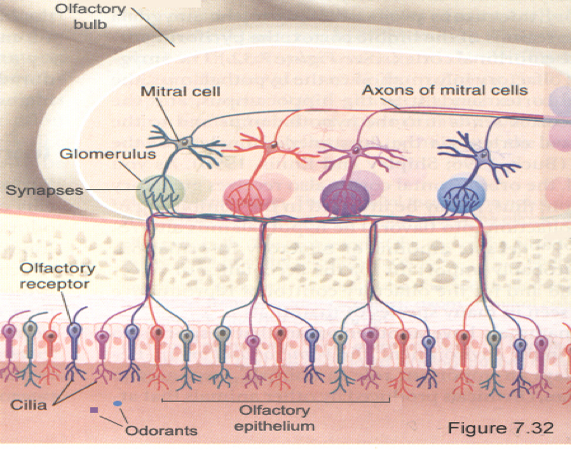Answer: Mitral cells are the second neuron in the olfactory system. Their cell bodies are in the olfactory bulb, and their axons make up the olfactory tract.
The sense of smell is an evolutionary ancient sensory system. In humans, our olfactory system is relatively weak, but still allows us to detect the presence of volatile chemicals that are floating in the air. This process is sometimes called chemosensation.
The olfactory system begins in the olfactory epithelium, which lines the inside of our nasal passages. The primary cells associated with scent detection are the olfactory receptor neurons. They send their dendritic projections through the epithelium, where they can make contact directly with the air that passes through the nasal passage. These dendrites express odorant receptor proteins, which can detect chemicals in the air. The axons of these olfactory receptors project through tiny holes at the base of the skull called the cribriform plate.
These neurons then synapse onto the mitral cells, the secondary neurons of the olfactory system. These synapses are found at one of many projection-dense areas called a glomerulus. Although each olfactory receptor expresses only one type of odorant receptor protein, each glomerulus contains the synapses from multiple olfactory receptor neurons that express the same odorant receptors. The glomeruli and mitral cells are in the olfactory bulb, while the axons of the mitral cells make up the olfactory nerve.
The dendrites of the mitral cells can receive inputs from four different cell populations. The olfactory receptor neurons, as described above, send excitatory projections. External tufted cells, which exist in the glomerulus, also send excitatory projections (External tufted cells: a major excitatory element that coordinates glomerular activity.) These neurons serve as one of the earliest stages of olfactory information processing. Two other cell types, the granule cells and the periglomerular neurons are inhibitory.
The axons of the mitral cells then project into the brain, synapsing in areas in the cortex such as the piriform cortex and entorhinal cortex, as well as limbic structures such as the amygdala. Neurons from the piriform cortex then project into other brain areas, including the mediodorsal nucleus of the thalamus. (The olfactory thalamus: unanswered questions about the role of the mediodorsal thalamic nucleus in olfaction)
